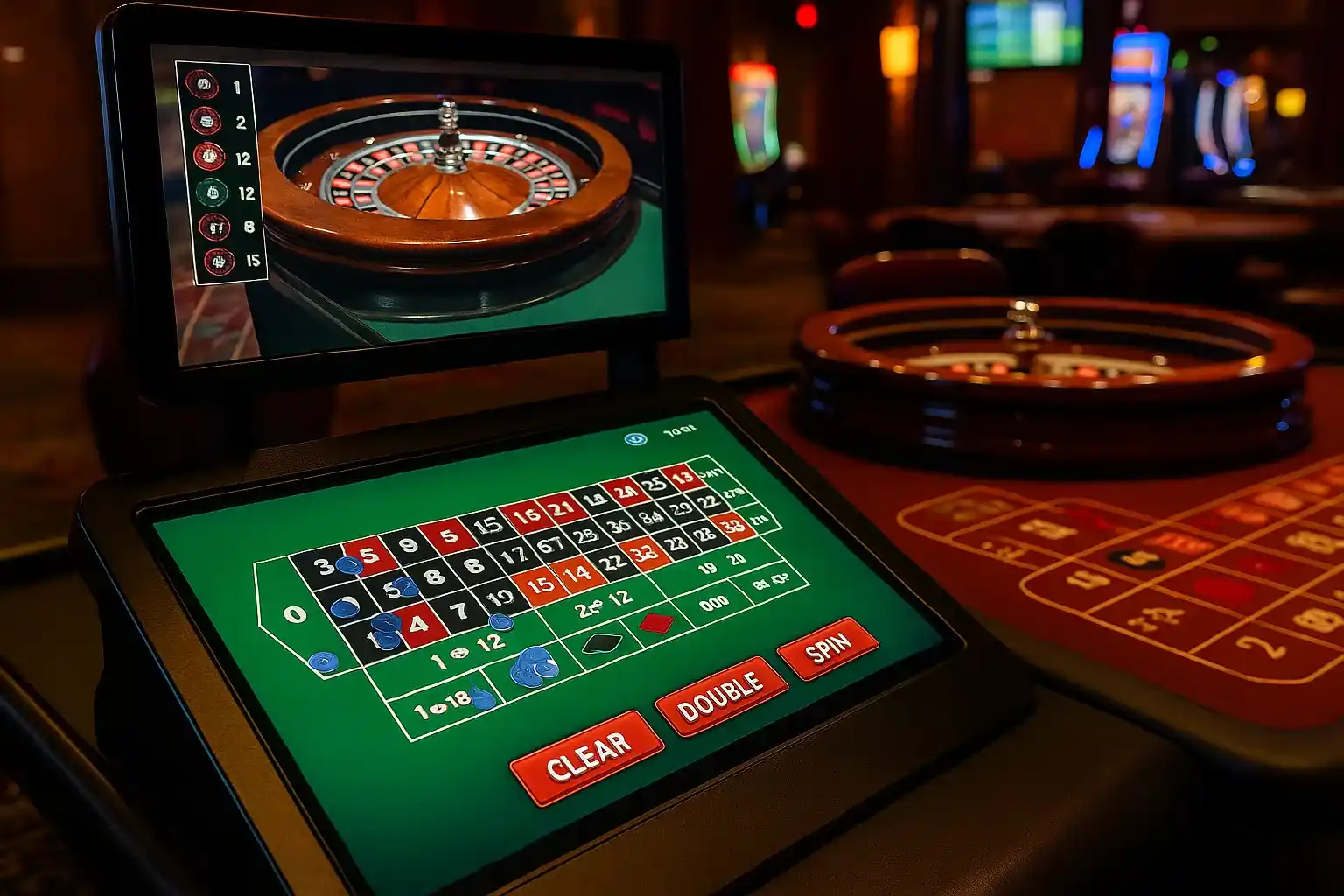Stepping onto a casino floor these days, you’re likely to spot the latest in roulette innovation: dual-screen tables that blend traditional spinning wheels with interactive digital displays. As someone who has watched these systems roll out across various venues—from glamorous Las Vegas resorts to boutique online live-casino studios—I’ve seen firsthand how they elevate the classic game. Dual-screen roulette tables offer faster gameplay, enhanced transparency, and a more engaging experience for players of all skill levels. In this article, I’ll draw on my personal observations and industry insights to explain why these hybrid tables are reshaping how we play roulette. Along the way, I’ll also cover how to find up-to-date casino platforms like the new slot sites 2025 uk list, ensuring you access the best technology and promotions.
Understanding Dual-Screen Roulette
Traditional roulette tables rely on a dealer spinning a physical wheel and manually managing bets on a felt layout. In contrast, dual-screen setups integrate that classic wheel with a digital touchscreen console positioned front and center. One screen streams a live camera feed of the spinning wheel, while the lower display acts as an interactive betting panel for players seated around the table or participating online. The result is a seamless blend of old-school charm and modern convenience. You still hear the satisfying click-clack of the ball on wood, but your bets are placed, tracked, and resolved electronically—often in a fraction of the time it used to take.
In my first experience at a dual-screen table in Macau, I was impressed by how quickly players could place complex bets—like neighbors, sectors, and racetrack propositions—without the dealer manually laying chips. The touchscreen drew a vibrant digital layout, and as soon as I tapped a series of outside and inside bets, I saw my wagers instantly confirmed. Meanwhile, the live camera above showed the dealer smoothly launching the ball. Within seconds, the winning number lit up on screen, and my account balance updated in real time. That fusion of tactile tradition and digital speed is what makes dual-screen roulette so compelling.
Faster Gameplay and Reduced Errors
One of the most noticeable improvements with dual-screen tables is the quickened pace of play. In a busy casino, you may recall dealers painstakingly counting chips, calling out “No more bets,” and placing markers on the felt. With a digital interface, that middle stage happens almost instantly. The screens clearly indicate when betting is open or closed, eliminating any guesswork. When the ball drops, the system automatically highlights the winning number, pays out successful bets, and clears losing tokens in a matter of seconds.
From an operational standpoint, this speed translates to more spins per hour. At a traditional table, an average of 35–40 spins per hour is common; dual-screen systems can push that number beyond 60, depending on table traffic. More spins mean a higher house edge in absolute terms but also more opportunities for players to win—or try their luck. Having tested both formats side by side during a weekend trip to Monte Carlo, I found that the digital system felt effortlessly streamlined. My friend and I bet on every spin without missing a beat, whereas at a purely manual table, we had to wait for the dealer to handle payouts and reset chips before placing fresh wagers.
Faster gameplay benefits players who enjoy volume. If you’re on a limited bankroll but want to keep the action roaring, dual-screen tables let you engage more intensely. Just remember to manage your bankroll carefully: more spins also mean variance plays a larger role in your short-term results.
Enhanced Transparency and Fairness
Roulette purists sometimes worry that digital integration could obscure the game’s fairness. However, top operators use audited Random Number Generators (RNGs) and certified camera systems to ensure legitimacy. In live-dealer dual-screen environments, the physical wheel is still the source of randomness, while the digital layer simply records outcomes and handles bets. Independent testing agencies—such as eCOGRA and iTech Labs—inspect each table’s software and hardware, verifying that the camera feed accurately matches the wheel’s landing pockets.
During a press visit to an online casino studio in London, I observed technicians calibrating high-definition cameras around the wheel, confirming that every pocket number was in sharp focus. Simultaneously, the touchscreen console displayed past results, allowing players to verify streaks or cold numbers in real time. That level of visibility fosters trust. Earlier in my career, I saw players debate whether a dealer might call a number incorrectly or mishandle chips. Dual-screen displays eliminate those doubts: what you see on the live feed is exactly what the system records and publishes. For both seasoned and novice players, that transparency makes the experience comfortable.
Improved Betting Options and Statistics
One major advantage of dual-screen systems is how they expand your betting possibilities. Traditional wheels are limited by the physical layout, but numerical touchscreens can overlay extra options, like sector bets (Voisins du Zero, Tiers du Cylindre) or neighbor bets without the dealer manually announcing them. To place a Voisins bet, I simply tapped the grouping on the digital racetrack; the software spread my configured chips across the correct numbers. In a regular casino, that might involve handling seven individual chip stacks, which can be both time-consuming and prone to minor placement errors.
But dual-screen tables go even further: they often provide live statistics—hot and cold numbers, previous sequences, and distribution charts. I remember playing an evening in Downtown Las Vegas where the digital interface showed that “15” had hit three times in the last five spins. While seasoned players know that past results don’t guarantee future outcomes, having those stats on hand can help me make more informed decisions. Sometimes, seeing the wheel favor a section over multiple spins can guide my neighbors or neighbor+1 bets. It’s also a great tool for beginners: being able to experiment with different strategies while watching visual feedback helps newcomers understand the game’s dynamics faster.
Seamless Integration with Online Platforms
Perhaps the most transformative benefit of dual-screen tables is how they bridge land-based and online play. With a single setup, a casino can allow virtual players to join a live physical table from anywhere in the world. The touchscreen console captures each participant’s bet, while the live camera streams the wheel action—often in ultra-high-definition. I experienced this firsthand last summer when I connected from my flat in Manchester to a studio table in Malta. I tapped my bet on the digital layout, saw the same camera angles I would if I were standing at the table, and chatted with other players through an integrated live chat feature. That hybrid model felt as authentic as being on the casino floor, yet I didn’t have to leave my home.
During that session, I placed a straight-up bet on 22 at just £1. After the dealer spun, the ball nestled into 22. Within moments, my account balance updated, and a notification popped up congratulating me. Before dual-screen systems, online roulette either used pure RNG software or separate live dealer formats that lacked the energy of a real casino. Now, with dual-screen, things feel more connected. If you’re a UK player curious about platforms offering this tech, check out trusted resources that track new launches. Finding “new slot sites 2025 uk” that integrate seamless live roulette features ensures you experience cutting-edge gaming without compromise.
Catering to Different Player Profiles
One of the most delightful aspects of dual-screen roulette is how it caters to varying comfort levels. For social gamblers who thrive on interaction, the live dealer and fellow players visible on shared tables create a friendly vibe. I’ve chatted with strangers from Canada and Germany while gathering around a 10-seat console in a Barcelona casino; the shared excitement when “17” hit was contagious. At the same time, solo players can focus purely on the screen. The digital interface lets you place bets discreetly, without the pressure of a crowded table. I often switch between in-person play and remote sessions, appreciating how dual-screen accommodates both moods seamlessly.
For beginners, the clear prompts reduce errors. In a traditional setting, I once watched a rookie accidentally place a chip between two numbers, thinking it covered both. That mistake cost him a €50 loss before he realized his chip was improperly situated. On dual-screen tables, if you tap the wrong spot, the interface highlights your selection, and you can adjust before confirming. That simple feedback loop builds confidence quickly—newcomers learn the bet types without fumbling physical chips.
Final Thoughts
Dual-screen roulette tables represent a compelling evolution in casino gaming, merging the tactile allure of the spinning wheel with modern digital convenience. They deliver faster rounds, increased transparency, and an expanded betting palette, while seamlessly bridging the gap between brick-and-mortar and online play. Whether you’re a high roller seeking maximum volume, a statistic-driven strategist, or a newcomer looking for guidance, these hybrid tables offer something valuable. My first-hand experiences—from lively casino floors in Vegas to remote sessions on my laptop—have convinced me that dual-screen systems are the future of roulette.
As you explore new gaming environments, keep an eye out for platforms adopting this technology. And if you’re based in the UK, consulting listings of “new slot sites 2025 uk” can help you discover where these tables are live and which operators back them with reputable licenses. With dual-screen roulette, the classic’s elegance remains intact, while digital innovation transforms every spin into a streamlined, engaging event. Give it a try—you might find that betting on both screens is your best move yet.










